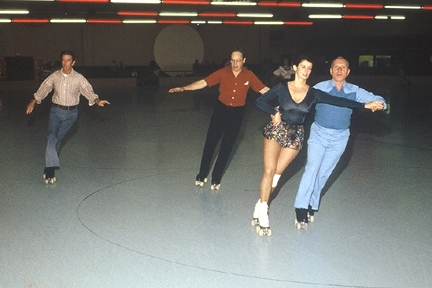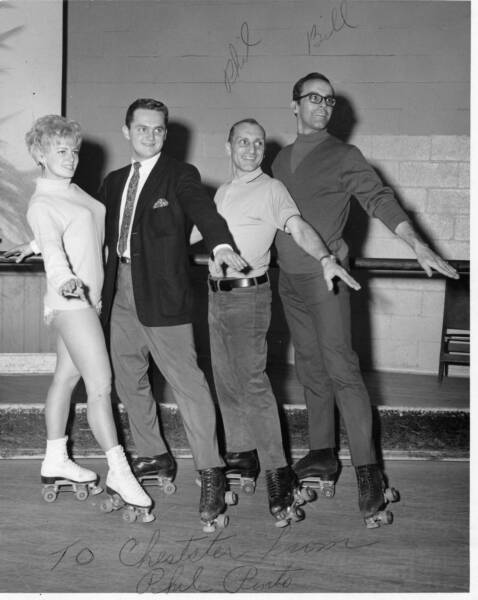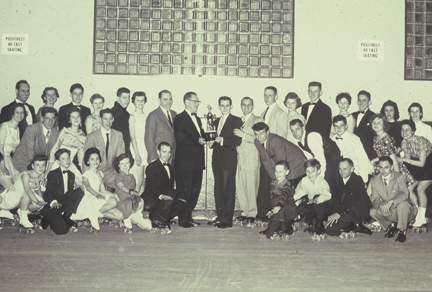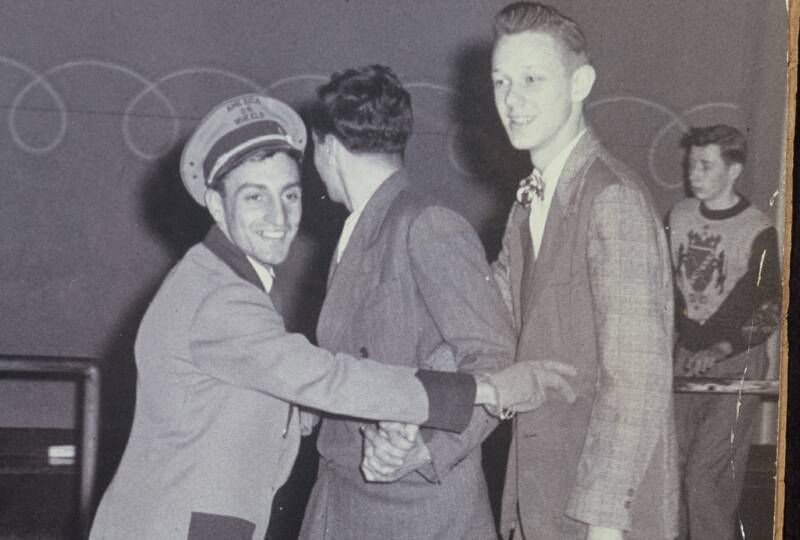Phil Pinto Remembered
by Bobby Russo
When Hackensack Arena was demolished on April 2, 2008, a precious bit of roller skating history was destroyed along with a part of my heart. It was at Hackensack Arena, exactly fifty years earlier — at the age of ten — where I first met Phil Pinto. Not only was Phil my revered skating coach, but he became a larger-than-life icon who, unknown to him, had a profound effect on many aspects of my life. In fact, Phil had such a positive influence on the direction my life took that, on a whim, I phoned him almost three years ago specifically to thank him for being "Phil". Sadly, I waited too long to make that call. His phone, a cold automated voice said, was no longer in service. As I was soon to learn, Phil Pinto had passed away, only about a year before, of heart failure.
How such a massively compassionate heart could ever have failed confounds me. I’ll always remember Phil as one of the sweetest, kindest human beings ever to lace up a pair of Snyder skates. According to his nephew, John, Phil was so good-hearted that he was sometimes taken advantage of. People would ask him for financial help, and Phil would generously, selflessly oblige . . . no documents drawn up, no questions asked. I wasn’t in the least surprised to hear that about Phil Pinto. It was totally in keeping with my recollections of the man.
All of us in the roller skating world know of Phil’s skating accomplishments, but in reality he was so much more than a beautiful skater and an excellent teacher. Some may not realize that he was a gifted tailor, who made most of the clothes that he wore! I recall walking into the rink one day in the 1960's to find Phil wearing a very colorful and unusual shirt. "Hey Phil," I said . . . "Where’d you get the cool shirt?" He replied, "It was a tablecloth this morning." All my life, I thought he was just kidding me, but his nephew recently explained that the Pinto family was, at the time, involved in the salvage business which just happened to give Phil access to a vast array of tablecloths. When he died, Phil’s closet was packed with hundreds of shirts that he had made. In addition to shirts, he also stitched together handsome vests and expertly detailed trousers, the quality and workmanship of which exceeded what can be bought in the finest of stores. Besides clothing, Phil also created things like zippered bags to hold skating tools and, later, a handy elasticized cloth device in which to store those pesky plastic grocery store bags. These kinds of items are now available commercially, but Phil’s versions were created decades earlier. In this and in many other ways, Phil Pinto was ahead of his time.
Anyone who knew Phil will attest to his outrageous sense of humor. One summer, on the way to Nationals in Livonia, Michigan, my mother and I were riding in Phil’s car. At one point we got stuck in stop and go early-July traffic. A bored and frustrated Phil noticed a jiggling, buxom woman walking along the roadside at a much faster rate than we were traveling. Without any warning, Phil shouted out of the open car window, "Hey, honey . . . walk a little slower. It’s hot out and you don’t want to shake those coconuts out of their tree!" I remember my mother sheepishly looking at me and the thirteen year old me looking at my mother for a stunned moment, and then both of us collapsing into a heap of laughter. Those were more innocent days (less politically correct days), and the endowed woman stopped walking, then turned and gave Phil and the rest of us a delightful smile. Riding with Phil was the best part of the trip.
Family was very important to Phil Pinto. He was one of eleven siblings which included two sets of twins — one set of each gender. Phil and his brother Louie were, in fact, fraternal twins (who really looked identical, especially in their younger years). Skaters who frequented Hackensack Arena will remember Louie as one of those natty, gray and maroon suited floor guards who effortlessly zigged and zagged through the throngs of skaters during public sessions. Louie Pinto may have been Phil’s look-alike twin brother, but the two had very different personalities. Louie liked to walk a bit on the wild side (he really had an eye for the women and he wasn’t particularly shy about it) while Phil was decidedly more mellow and kept his private life very much to himself. Into adulthood, Phil and Louie shared the Pinto family home at 137 Monroe Street in Garfield, New Jersey, with their wheel-chair bound mother — essentially until their deaths. Sadly, Louie died prematurely of a heart attack at the age of fifty-eight. After his mom passed away, Phil continued on in the ancestral home; however, he was to be briefly confined to a nursing home at the very end of his life. Phil loved his family and gloried in the fact that he had twenty-four nieces and nephews! Two of his nephews, by the way, are in the Rock and Roll Hall of Fame . . . one as a member of the group The Rascals and the other as a member of Joey D and the Starlighters. Because of the size of the Pinto clan, Christmas was reportedly done in shifts and New Year’s Eve was described as verging on pandemonium. It comforts me that Phil had such a large, loving and supportive extended family. They fondly remember "Uncle Phil" and they are very proud of his skating and other accomplishments.
During World War II, both Phil and his twin were in the U.S. Army, coincidentally stationed near each other in Africa. One harrowing night, Phil went to sleep in a foxhole with his rifle positioned across his chest. He was abruptly awakened by the sound of gunfire ricocheting off his rifle. He would have been surely killed if not for the exact positioning of his own gun, so it was evidently not Phil’s fate to become a war statistic. As we now know, he had some serious skating, teaching, choreographing, costume designing, tailoring, wise-cracking, living and loving left to do!
As a skating teacher, Phil was as generous as he was in his private life. Your time with him was your time, and he gave you his full attention for the duration of your lesson. In my mind’s ear I can still hear him calling out "No lunging!!!" or "Bobby! No sub-curves!" Then there were Phil’s tutorials at the boards where he’d take a number two pencil to steno pad (it was always a steno pad) and expertly draw out the pattern of whatever dance you were working on. After he illustrated a dance pattern for you, it was almost impossible to forget it. You knew from his precise drawings, for example, that a right inside edge cut through the exact middle of each corner during the Straight Waltz and that the correct pattern for The Collegiate should resemble the shape of a dog bone. When a direct demonstration was in order and Phil partnered you, you suddenly became a much better skater than you’d been just a moment ago! Your posture improved as did you edging as did your overall presence. It was difficult to skate with Phil and not have a big smile on your face. And he remained the same wonderful Phil through decades and decades of being a skating professional.
We can certainly appreciate Phil’s contributions to the roller skating world by contemplating the long list of highly accomplished skaters who were, at some point in their competitive careers, coached by him. Many rose to the level of national champions and several became world competitors. What an amazing legacy! All of these skaters took a part of Phil Pinto with them to the pinnacle of their sport.
After more than sixty years in the sport he adored, Phil Pinto retired from roller skating approximately nine years before his death. His heart condition (he’d had open heart surgery) and perhaps changing times at the Montvale Roller Rink, where he’d been teaching, finally conspired to nudge him, regretfully, into hanging up his skates. In retirement, he spent a number of years in Hawaii, where some of the musical members of his family had re-located. Phil loved Hawaii and he got to thoroughly enjoy this tropical paradise before ill health eventually forced him to return to the care of family in New Jersey, where he eventually passed away at the age of eighty-four.
Some misguided people might say it’s "progress" that toppled the once beautiful and renowned Hackensack Arena. I, on the other hand, call it "sacrilege". The building’s physical demise, however, is nothing compared to the loss of our beloved Phil Pinto. If I could see Phil one more time, I’d be sure to tell him that he is one of my heroes. He taught me so much . . . not just how to skate without lunges and sub-curves, but that a life is best lived by being true to yourself and that human creativity is a direct path to joy. I miss you, Phil. Always will.











































